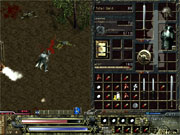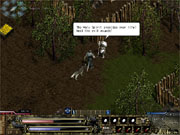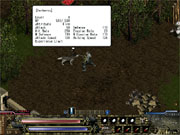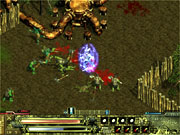ShadowFlare Preview
Take a look at the Diablo-style game that was released in Japan last year.
Ever since it first appeared many years ago, Diablo has had an undeniable impact on the gaming industry. It revived RPGs, introduced Battle.net, and spawned some unsuccessful clones. It was also a great international success, and in Japan, it inspired a popular game called ShadowFlare. By all appearances, ShadowFlare seems to be derivative of Blizzard's great role-playing game, but it isn't just a mindless clone. It has a unique style of its own, thanks to its Japanese roots and its greater emphasis on action gameplay.
ShadowFlare arrived in Japan in October 2001. While PC gaming isn't nearly as big in Japan as console gaming, ShadowFlare still managed to impress fans at the Tokyo Game Show and after its release. Now, EmuraSoft has decided to bring the game to the US to see if it can win fans as Diablo did those many years ago. ShadowFlare was a hit in Japan, but can it fly in the United States? We recently got our hands on a beta of the game to see if this RPG really has the goods to compete in the dynamic role-playing game market here.

Upon first glance, ShadowFlare is very familiar in the way it looks and plays. You control one character in an isometric view as he or she roams the countryside looking for things to kill and corpses to loot. When trouble does come your way, you just click as furiously as you can with the left and right mouse buttons until nothing but bodies lie around you. The 2D graphics seem quite outdated, and they're reminiscent of the graphics in old 16-bit cartridge games, but the sprites are large and the environments have a number of animated elements, like great machinery in the countryside that belches out rolling steam.
Some of the elements that betray the game's Japanese origins are the lighthearted music, which sounds like something you might hear in a console RPG, and the smattering of high-tech aspects in a largely fantasy-themed world, like the aforementioned steam machinery and the laser turrets guarding the dungeons. It is a little incongruous, and it will undoubtedly jar your suspension of disbelief when you have to dodge your first rapid-fire laser trap.
The story of ShadowFlare is quite simple. World civilization was cruising along for centuries until a malevolent demon from beyond appeared and brought a legion of fiends with him. These creatures assaulted the human kingdoms and killed countless numbers of people. Now, humanity has huddled into its last remaining cities in a war-torn landscape. Most are content to simply wait out the rest of their lives from behind shuttered windows, but a rare few have the courage to sally forth against the demonic invaders. You are one such mercenary, who is working for the beleaguered and depleted city guards of a small town in the thick of a monstrously overrun countryside.
ShadowFlare is split into episodes (like Diablo II's acts), and the first episode begins in this remote town. The flavor text at the beginning of the game notes that a new breed of demon called the gargoyle has been sighted nearby lately, and that only the greatest of heroes (which would be you) can hope to defend humanity from these vile creatures. Thus the game begins. Interestingly, unlike other games, ShadowFlare will apparently be available as a download rather than through the normal distribution channels. Furthermore, the game will be split into four separate downloads divided by episode. The first episode is slated to release in mid October, and the next three episodes will follow in November, December, and January.

Initially, you're just a sword-wielding mercenary. This is the default class of the game. You can choose to be either male or female, although it appears that there is no difference in stats, just in the appearance of your hero. As you roam the wilderness and dungeons, you'll find various evil creatures to battle. Like in Diablo, some will drop items and gold, which provides you with your primary source of income to purchase new equipment.
Earth, Wind, and Fire
Helping you in your battle against the enemy is your trusty animal companion. You begin the game with a dog, and in later episodes you'll be able to trade up to a hawk. The animal companion is a unique addition to the action RPG formula. He's a henchman who is AI-controlled, and he attacks enemies on sight if you unleash him by making him "active." Your animal companion starts out inactive, and in this state, he'll just follow you around. He will not attack enemies, but you can manually control him to make him pick up items or perform single attacks on foes (meaning he'll dash at them once and then sit again). In this state, he is invulnerable to attack and heals rapidly. If you want the help of your animal companion in battle, though, you can click on his status bar to activate him, at which point he attacks all foes on sight. The dog has a tremendous number hit points compared with your character (about five times more, initially), and he can take out packs of goblins without breaking a sweat. If you later wish to change animal companions, there are several other dogs just waiting for a new master in town, so you can test different canines until you find one that suits you. Most dogs appear to be the same, although some have slightly different stats and are aligned to different elements, like water or fire, which makes them better against certain elemental creatures.

As you gain experience, you'll start to level up. And as you level up, you'll be introduced to ShadowFlare's unique class system. At around the fifth level or so, if you've been hacking away at enemies with your sword, you'll change careers and become a warrior, which is ShadowFlare's term for a simple fighter. The game has three main classes (not counting the introductory mercenary): warrior, wizard or witch, and hunter. As you increase in level, you'll have the option to switch to the wizard or witch classes (depending on gender) or the hunter class. Each class is particularly adept at one style of fighting. The warrior is good at melee combat, the wizard is proficient with magic, and the hunter is skilled with long-range weapons like bows. It's like the warrior, sorcerer, and rogue all over again, but with a twist. If you don't like one class, you can simply switch to a different one after a few levels. You can only switch when you level up, so you can't indulge your indecision by going back and forth constantly. Moreover, once you switch, it's difficult to switch back if you find the new class is not to your liking. It was unclear when the opportunity to change careers would pop up, although it seems tied to how much you use a class' preferred fighting technique. For example, all we did was fight with our sword, and at the fifth level, we automatically became a warrior. But we decided to change tactics and started hurling plasma spells at enemies, and at level eight, we were rewarded with the opportunity to change to a wizard. We did so, but the experience seemed the same. We didn't gain new spells, and the game didn't give us any feedback as to when our next spell would come and what it would be. Presumably, if we'd switched to the bow and started dispatching enemies from afar, in a few more levels, we would have been able to switch to hunter.

ShadowFlare throws out a continuous wave of creatures at you, although we only tangled with bats, goblins, and NPC goblinoids in the initial wilderness and first dungeon. The equipment also seemed pretty simple in the first episode--we were mostly using daggers, short swords, crossbows, and leather armor. An annoying feature that seems straight out of Diablo is the inability to save anywhere. You can save your character and quit, but when you reload your game, you have to replay all the levels again. Helping you get around, though, is the "transport gate" system, which is similar to Diablo II's town portal system in that it lets you teleport to previously explored regions of the game. The designers have also introduced an original gameplay mechanic in the elemental system that tracks your character's attributes in eight elements: fire, water, earth, air, holy, dark, gel, and metal. Each element is tied to a specific ability, like your attack strength, hit rate, magic attack, magic defense, and so on. You'll be able to find magic crests that you can wear to increase your elemental ranking and thus improve the attendant abilities. Moreover, all creatures in the game are tied to a particular element, and if you are strong in an opposing element (like water vs. fire), you'll do more damage to that creature.
ShadowFlare is an awful lot like Diablo, but it has its own unique charm. It doesn't look like much, but role-playing gamers who want a little Japanese flair in their adventuring might want to consider this game when it is made available for download next month.
Got a news tip or want to contact us directly? Email news@gamespot.com
Join the conversation